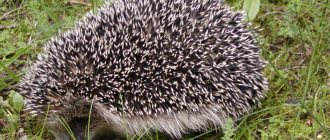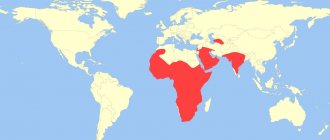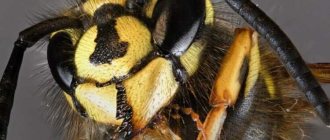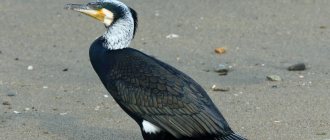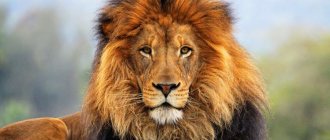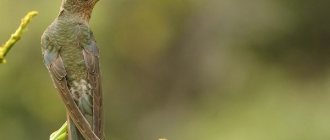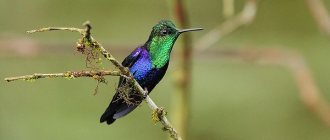Reindeer can rightfully be called one of the most amazing animals. His stature, pride and greatness amazes us since childhood, when we read about this amazing inhabitant of the northern latitudes in books. In many other countries, this animal is no less popular; it brings joy to children at Christmas when it brings Santa Claus to the holiday. However, few of us manage to see it live - many species are on the verge of extinction and are becoming less and less common in the wild. However, everything is in our hands; we can still change situations and turn the vector in the right direction.
Where do reindeer live?
This unique creature prefers a harsh climate; it can be found in the vast expanses of North America, Russia and some European countries. The climatic zones of tundra, taiga and, oddly enough, mountains are perfect for its habitat.
In summer, they most often live on the coast, in winter they move closer to forests. There is less snow there than in open spaces and it is much easier to get food. When migrating, reindeer in the tundra can cover significant distances, sometimes up to five hundred kilometers, and even swim across rivers. When spring comes, they again rush to open spaces.
Habitats
This proud animal can be found on the Kola Peninsula and Kamchatka, Western Chukotka and northern Sakhalin. Lives in North America and Canada. There is a very large population on the Taimyr Peninsula.
The harsh tundra and semi-tundra are ideal places for the life of horned beauties, where they have lived for thousands of years. So, knowing where reindeer live, if you wish, you can go and admire them in the wild.
Appearance
Reindeer is a very recognizable animal and is difficult to confuse with other artiodactyl mammals. Like other animals, its appearance is determined by its habitat. This stately beast is of medium size, body length is no more than two meters, height is about one meter. There are individuals that are much taller - about one and a half meters. The color is closer to brown in summer, light brown in winter. The weight of a male can reach one hundred and eighty kilograms, females most often do not exceed one hundred and twenty.
Representatives of this species do not have the same grace as their counterparts from other subspecies, they do not need it, but, thanks to the structure of their body, they can move perfectly even through large snow and swampy places. When moving, they can make sounds that resemble knocking. This helps them not to get lost and always find each other.
The pride of the reindeer in the tundra is its antlers, and this is not surprising, because they are much larger and more branched than in others. In males they are larger than in females and can reach one hundred and fifty centimeters in length. Adult males lose their horns annually, after the mating period, while females shed them after the birth of their cubs.
Only female reindeer have antlers; females of other species do not have this advantage.
Difference from roe deer
Roe deer, which are also part of the deer family, differ from the latter in a number of ways:
- The antlers of a roe deer do not have branches, like those of a deer.
- Roe deer, unlike deer, will never eat tree bark; otherwise, their diet is largely similar.
- There is a difference in feeding their offspring: if female deer feed their young while standing, roe deer do this lying down.
On the left is a deer, on the right is a roe deer.
The lifestyle and habits of reindeer
Reindeer live in herds, in which a leader can be clearly identified. Within the herd they form groups of up to ten to fifteen individuals with a male at the head. The male leads his nomadic harem of several females with cubs. It is easier to live in a herd than alone. It is much easier to feed yourself and protect yourself and your kids.
The interesting thing is that:
- The route does not change, and from year to year the herd wanders along the same path.
- Every year the male has to defend his females, and if he fails, he will lose not only his leadership, but also his entire harem.
- In areas favorable for life, reindeer could be quite large, up to several thousand heads, however, now they have become much smaller.
Difference from moose
Although moose and deer are close relatives and sometimes the moose is even mistakenly called the largest deer, there are a number of differences between them:
On the left is a deer, on the right is an elk.
Varieties
Depending on their habitat, tundra, forest and mountain reindeer can be distinguished. However, all this is very conditional and it cannot be said that the mountain one does not live in forests, and the tundra one does not climb the mountains.
In America, perhaps the most common subspecies are Greenland and Caribou, in Eurasia:
- European
- Siberian
- Okhotsk
- Barguzinsky
Video
And finally, an interesting documentary about reindeer.
Author: Pavel Chaika, editor-in-chief of Poznavaika magazine
When writing the article, I tried to make it as interesting, useful and high-quality as possible. I would be grateful for any feedback and constructive criticism in the form of comments on the article. You can also write your wish/question/suggestion to my email [email protected] or Facebook, with respect, the author.
Author page
This article is available in English -
Deer.
Nutrition
Reindeer in the tundra feed on what nature gives them. In winter, they find lichens and grass debris under the snow, but of the variety of plants they prefer moss, which is a lichen and grows in fairly large quantities in the northern regions. This plant is quite well digestible, but for complete nutrition they need to replenish the lack of salts in the body, which is formed due to a meager winter diet. To do this, they drink sea water or chew their horns.
In the summer, they eat various berries, mushrooms, and other herbs; they like to pamper themselves with succulent tree branches and leaves. They eat eggs, small animals such as rodents and even poultry.
Domesticated reindeer do not need to find their own food - people take care of them. Their main food can be considered cereals, hay and even silage.
Super abilities
Unusual abilities allow deer to survive in the harsh northern terrain:
- They can dig through a meter-thick layer of snow in search of their favorite delicacy - reindeer moss. They usually dig snow with their front legs, which have a special structure: the edges of the hooves are pointed, and their entire surface is slightly concave.
- Deer swim well. To some extent this is due to their fur. The hairs are hollow inside. The air with which they are filled allows the animals to stay afloat.
- In summer, deer fur is short, and in winter it can reach such a length that a “mane” forms in the neck area. This allows the artiodactyls to feel comfortable at any time of the year.
Reproduction
At two years of age, reindeer reach maturity and can produce offspring.
The mating season begins around mid-autumn, usually before November. At this time, males enter into a ritual fight for females; these fights are usually quite peaceful and do not end with the death of the loser, most often he simply leaves. Without the presence of females, fights do not take place. The strongest male can gather a harem of up to fifteen females. After the rut, males are not close to females; they usually stay away.
Eight months after the mating season, cubs are born, usually one, much less often - two. They weigh about six kilograms, but are already quite strong. Nature created them this way, because the time of their birth coincides with the time of the beginning of migration, and here everyone has to be strong and resilient. Babies are not at all afraid of the cold and already on the second day they can not only stand, but also run after their mother; by the beginning of the second week of life they can already cross the river. They feed on milk until the beginning of winter, then they switch to full-fledged adult food.
Females can bear offspring for quite a long time, and their total lifespan can reach twenty-five years.
Enemies of reindeer in the wild
In nature they have a sufficient number of enemies. Wolves prefer to hunt them, but sometimes they are attacked by lynxes and wolverines. While it is easier for a herd to deal with individual individuals, it is much more difficult to deal with entire packs of wolves.
Deer are also susceptible to such serious diseases as rabies, and helminths can also bring them a lot of trouble.
Gadflies also annoy them. They lay their larvae under the skin and wounds form in these places, which can rot and be very disturbing. In addition, gadflies can lay larvae directly in the nostrils. The body spends quite a lot of energy fighting this disease and quickly becomes exhausted.
Humans also cause significant harm to these beautiful animals by hunting them for their valuable fur and horns. Reindeer meat is also very popular.
Grazing of domestic animals in areas where wild reindeer migrate reduces the size of the herd due to the lack of adequate nutrition. They also suffer because forests are being cut down and people are beginning to develop territories that were previously wild and fully used by animals.
Therefore, representatives of this breed now live in places inaccessible to humans, although previously they could be observed in more southern areas.
Interesting Facts
- Deer antlers have healing properties in the treatment of hypertension and nervous diseases. Which, of course, is not good for the deer themselves, many species of which are already listed in the Red Book, as they are on the verge of extinction.
- Among many peoples and at different times, the deer was revered as a sacred animal, for example, the Mayan Indians sometimes even called themselves “deer people,” and the deer was considered their main tribal ancestor. Among the ancient Celts, the deer was considered a symbol of the Sun, fertility, vitality, and was personified with the god Cernun, whom the Celts depicted with deer antlers.
- Often the image of a deer can be found in medieval heraldry, where the deer symbolized grace and moderation.
Life with people
Reindeer get along well with humans. Domesticated about two thousand years ago. These peaceful animals, having a calm disposition, quickly got used to their new living conditions.
This is an ideal draft animal; it is also used for riding, but this is less common. If you need to travel long distances in difficult conditions in the north, then these animals are best suited for such events. It is quite easy for him to move in difficult snowy conditions and even in the mountains, and besides, he can find his own food by eating pasture.
For the peoples of the Far North, deer meat and fat are very valuable; they help restore the vitamin balance in the body and increase immunity. Deer meat is not only rich in various microelements, but also quite tasty. For local residents this is more of an ordinary food, but for residents of the central and southern regions it is a real delicacy, so it is not cheap. In addition, it is quite low in calories and this quality adds even more value to it. Most of the animal's internal organs and even blood are also eaten.
Fur and sinew are used everywhere by local residents, both for home improvement and for sewing clothes and shoes. Many medicines are made from horns and hooves, as well as boxes and other souvenirs.
Domestic animals are smaller than wild animals, most likely due to the fact that they do not have the need to protect themselves. The color is also slightly different; white individuals are more popular. Some instincts are not so pronounced, for example, the migration instinct. But the herd feeling is more developed, which allows them to get along calmly in small territories.
Reindeer hunting
Most often, hunting occurs not for meat, but for the sake of entertainment and original leisure. It is carried out mainly in the fall, during the rut. To find out whether it is possible to hunt in your region and where it can be done, you should contact the hunting society. They will tell you whether it is possible to obtain a license, what is needed for this and how much it will cost. When you can hunt and what species, and how many animals you can kill.
It’s quite easy to get a hunting license in America; in Russia it will be more difficult and it won’t be cheap. You can only hunt in areas specially designated for this, although many amateurs do not disdain poaching and shoot in the places where they want, ignoring all the rules.
Security
Uncontrolled shooting and other problems prompt the conservation of many species of reindeer in the tundra. Wildlife sanctuaries created in Russia and other countries help control the population of each individual species. They reproduce and protect those species of animals that are at risk. They maintain their numbers at an optimal level, take care of their habitat and fight poaching.
Both uncontrolled shooting and an unexpected increase in numbers have a rather negative impact. Herds in search of food in some regions can come very close to residential settlements, thereby harming local residents. Therefore, in those places where their habitat borders on human farms, it is worth taking care of the number of these animals.
Grant's caribou make the longest migratory journey
Grant's caribou (Porcupine caribou or Rangifer tarandus granti) live in Alaska and western Canada. In this area they are better known as Porcupine caribou. This name refers to the Porcupine River, which extends over a large portion of their range. During their annual migration, the animals cover about 2,400 km, traveling from their wintering grounds in the forest-tundra and taiga to the Beaufort Sea. This is the longest migration route traveled by land mammals.
Granta caribou remain an important resource for many local indigenous peoples. However, the animal population is controlled by government agencies in Alaska and Canada. This made it possible to significantly increase the number of individuals in this territory. As of 2022, the herds number about 218,000 animals, which is almost double the number in 2001.


